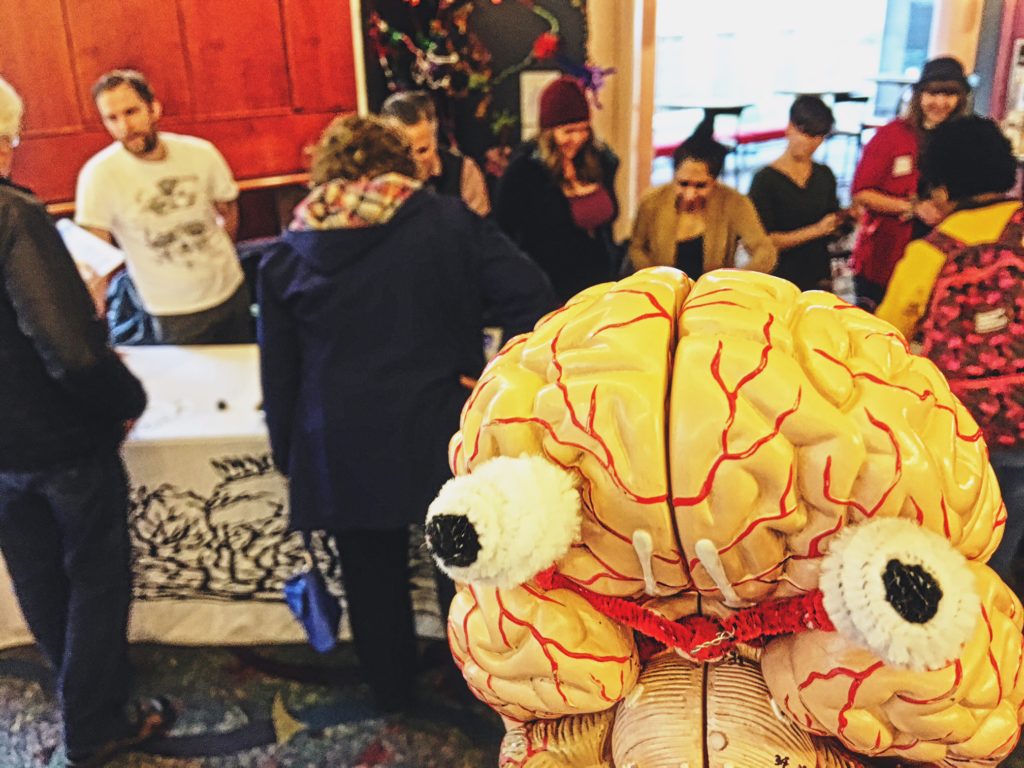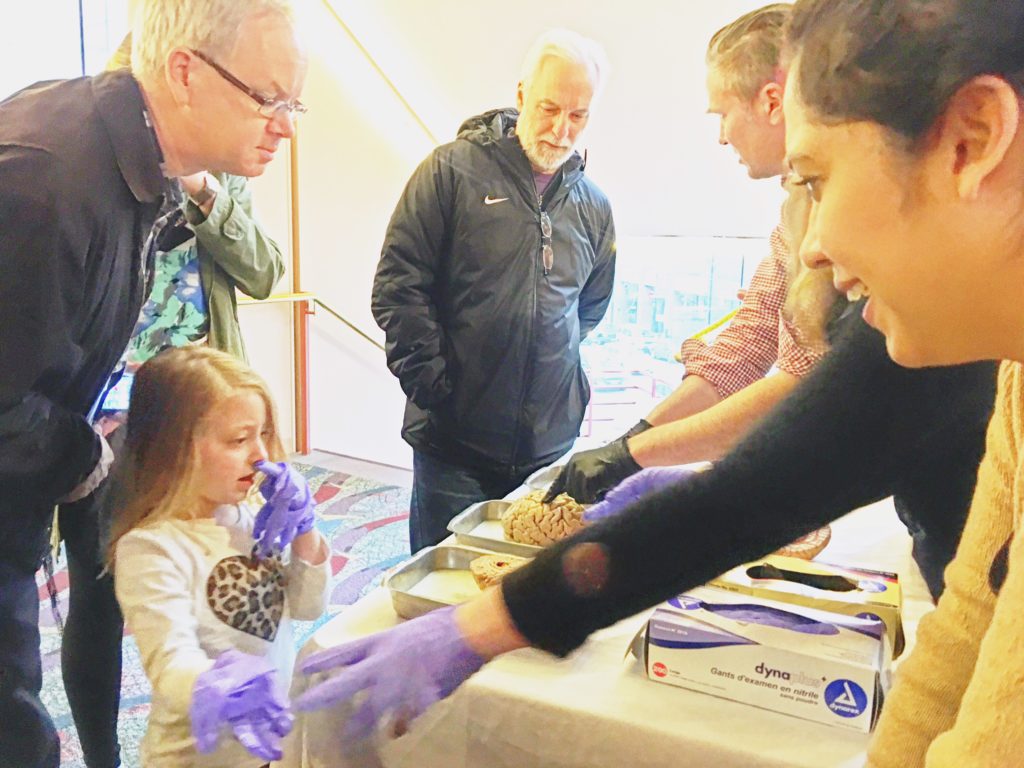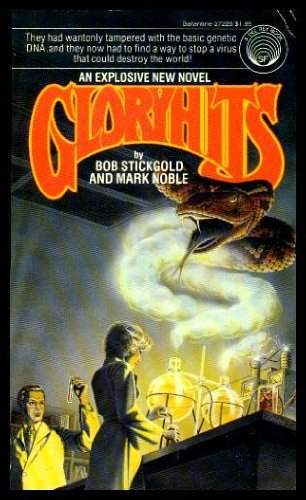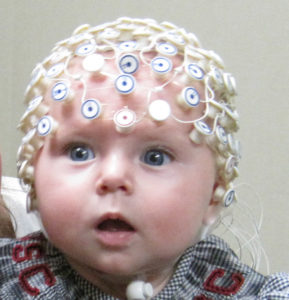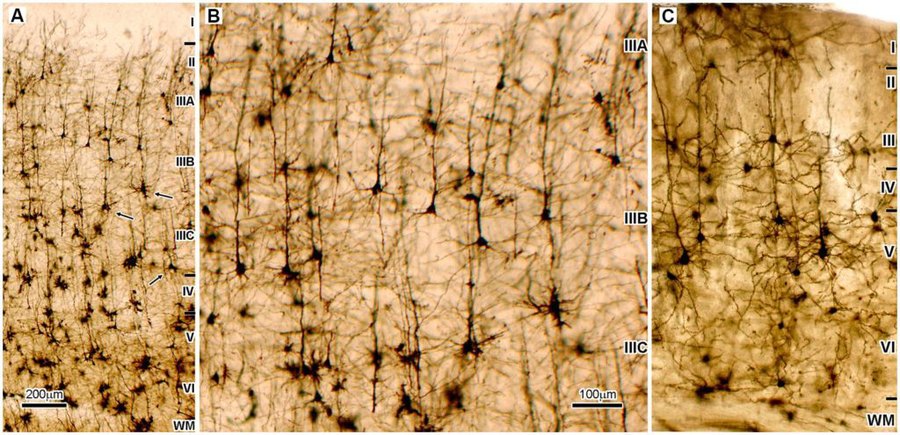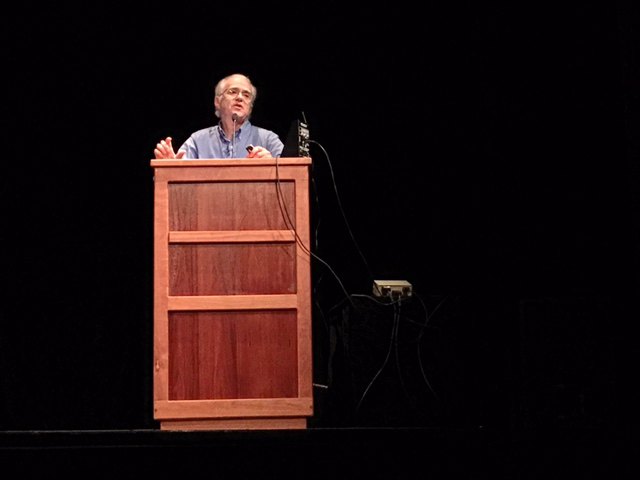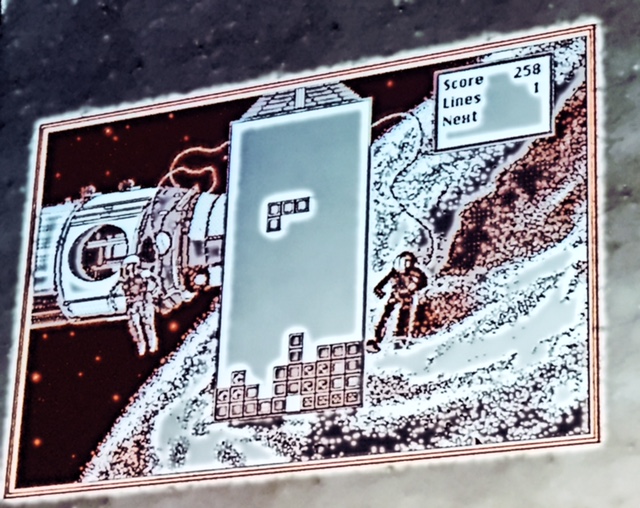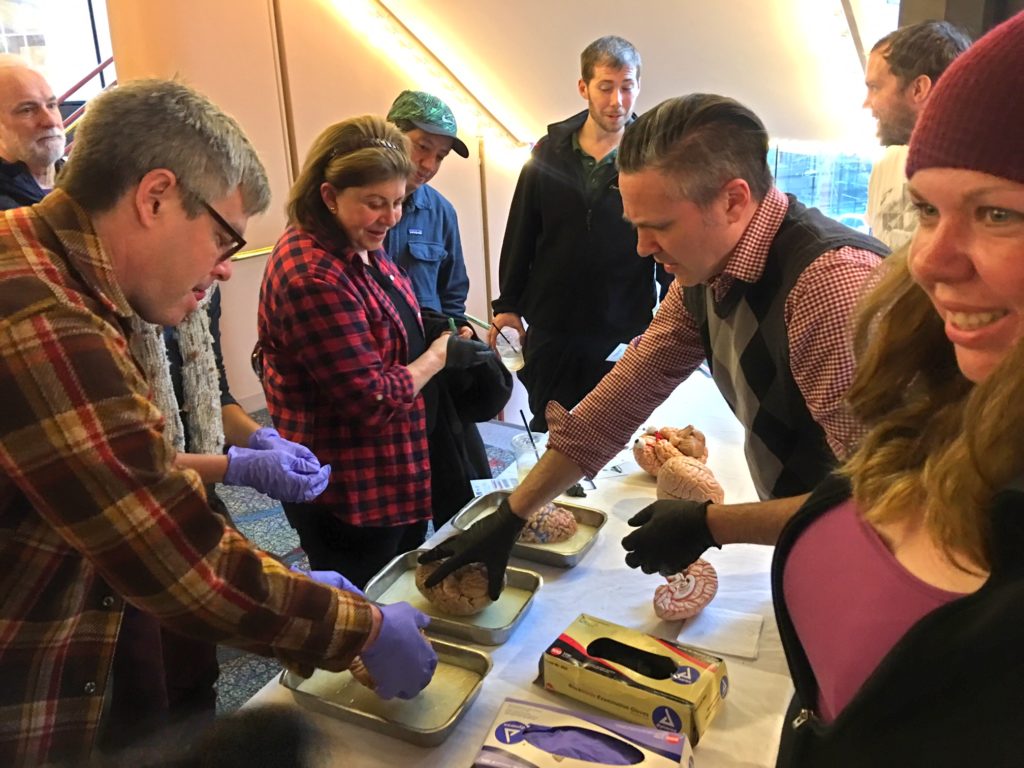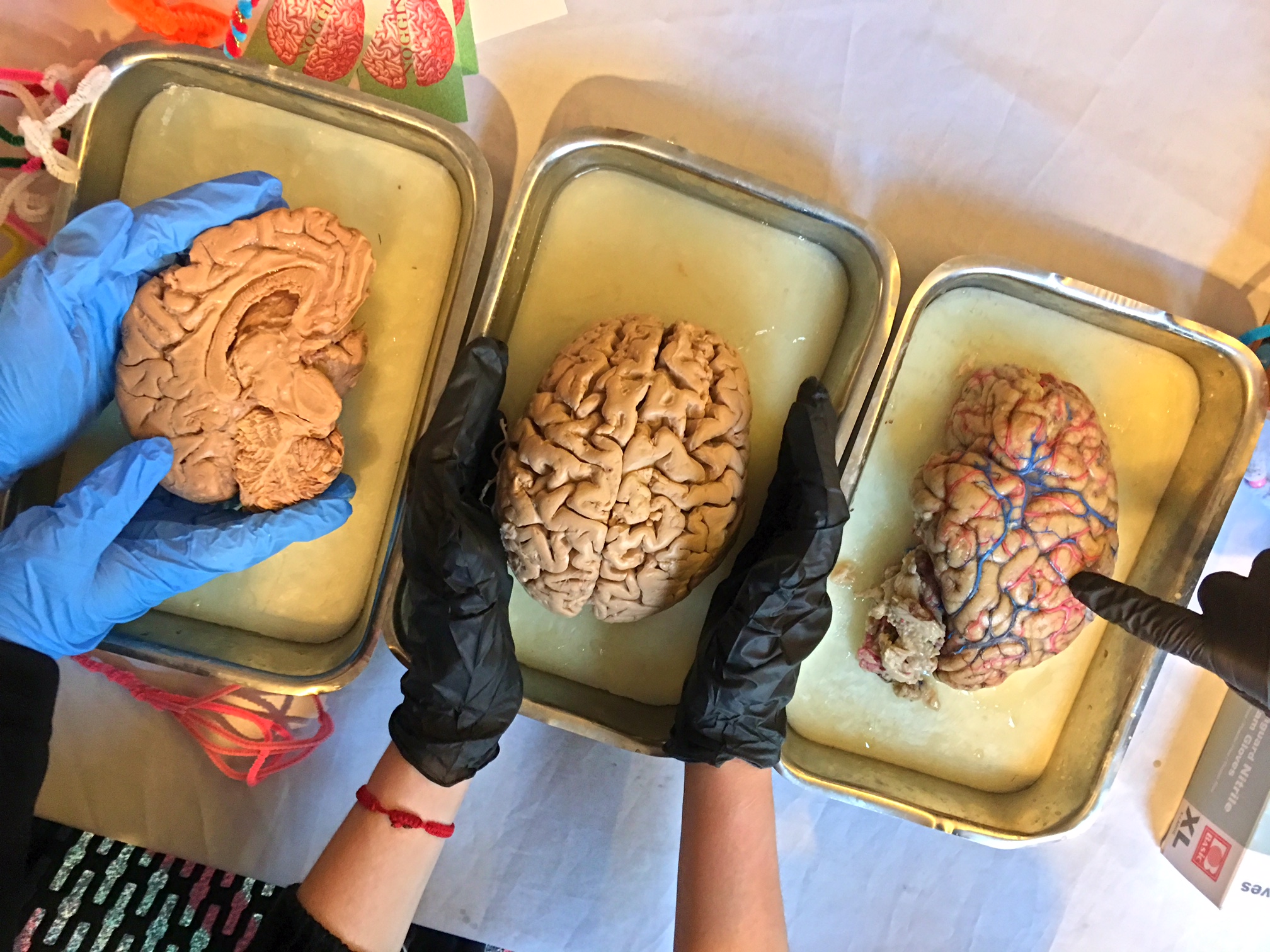From Breakfast on through all the day
At home among my friends I stay,
But every night I go abroad
Afar into the land of Nod
– Robert Louis Stevenson
Our volunteers get more questions about sleep and dreams than almost any other topic. Adolescents, often beset by anxiety and subject to school schedules that fail to address the circadian shifts in their changing brains, may struggle to get adequate slumber, and are fascinated by what happens when they finally close their eyes…
LEARN MORE: Sleep in Adolescents: The Perfect Storm
LEARN MORE: Adolescents’ sleep behaviors and perceptions of sleep
Thanks to the generosity of Kate Stout at the OHSU Brain Institute, Noggin brought ten curious volunteers to the Newmark Theater this week, including Brit Gratreak, Jessica Patching-Bunch, Leota Wolford, Sulema Rodriguez and Heather Hamilton from Psychology at Portland State University, Jeremy Dunford, Erin Cooper, Christina Williams and Imee Williams from WSUV, and Noggin Board member Kindra Crick…
We came to hear Robert Stickgold, an Associate Professor of Psychiatry in the Division of Sleep Medicine at Harvard Medical School and Director of the Center for Sleep and Cognition at Beth Israel Deaconess Medical Center discuss research on “Sleep, Memory and Dreams…”
Dr. Stickgold has authored over 100 research articles – but he also wrote two pulp novels potentially inspired by his own nightmares..!
“Your brain doesn’t turn off when you go to sleep,” said Dr. Stickgold, noting how we typically experience several 90 minute cycles of distinct sleep “stages,” including slow wave sleep (SWS) and REM sleep – named, he explained, “after the band… :)”
Different sleep stages, suggested Dr. Stickgold, evolved to accomplish different tasks, several related to memory. Sleep stages are distinguished by a technique known as electroencephalography (or EEG), which detects the coordinated, aggregate electrical activity (“post-synaptic potentials“) of linearly organized pyramidal cells in areas of our wrinkled neocortex…
IMAGE SOURCE: Cortical pyramidal neurons have pyramid-shaped cell bodies and linearly oriented processes
LEARN MORE: Electroencephalography (EEG)
REM actually stands for “rapid eye movement” sleep, which is most linked to dreaming, and we tend to get more REM (and dreams!) in the early morning hours. EEG waveforms recorded during REM are low amplitude, which means that smaller groups of pyramidal neurons are simultaneously active, with different clusters of cells processing different perceptual and cognitive aspects of a dream. In contrast, the slower, higher amplitude waves of SWS (see Stage 4 in the figure above) each represent many more nerve cells “cheering simultaneously.” Many cortical neurons all doing the same thing means less processing of information and a corresponding absence of extended, vivid dreams…
LEARN MORE: What is REM sleep?
LEARN MORE: Slow Wave Sleep: Does it Matter?
LEARN MORE: Why We Sleep
The electrooculogram (EOG) clearly identifies the REM stage, as those rapid eye movements provoke changes in this recorded signal. Your body is also typically paralyzed during REM, so an electromyogram (EMG) will detect far less activity, allowing you to roam freely in your dreams – but not in reality…
This REM-linked atonia evolved to let us sleep without hurting ourselves, or others. However, some people do not experience paralysis, said Dr. Stickgold, and may act out their dreams. They suffer from what’s known as REM sleep behavior disorder, which can have terrifying consequences…
LEARN MORE: REM Sleep Behavior Disorder
So what accounts for these important shifts between the waking state, and the various stages of sleep? The release of dopamine (DA), norepinephrine (NE), serotonin (5-HT) and acetylcholine (ACh) – all “neuromodulatory” neurotransmitters – determines our level of arousal. While awake and engaged in daily tasks, you experience activity in these transmitter systems. However, as you get drowsy and ultimately fall asleep, the release of these arousing neuromodulators drops…
Interestingly, during REM, acetylcholine (ACh) releasing neurons in the brainstem (in a region known as the pontine tegmentum) selectively switch ON, stimulating interactions between the cortex and another brain structure called the thalamus, which processes incoming sensory information. Your eyes move faster, your body is paralyzed, and you’re now often dreaming in the Land of Nod…
All by myself I have to go,
With none to tell me what to do–
All alone beside the streams
And up the mountain-sides of dreams.
– Robert Louis Stevenson
LEARN MORE: Optogenetic activation of cholinergic neurons in the PPT or LDT induces REM sleep
LEARN MORE: REM Sleep Regulating Mechanisms in the Cholinergic Cell Compartment of the Brainstem
In addition, emotionally significant areas of your brain, including the subcortical amygdala and a medial region of cortex called the anterior cingulate, become more active, while “executive” regions in the frontal lobes (including an area known as the dorsolateral prefrontal cortex, or DLPFC) quiets down…
Thus, according to Dr. Stickgold, our dreams can be “hyper-emotional and bizarre, with logical constraints removed,” and most of us lack control over the stories we tell in slumber…
Dr. Stickgold then presented evidence for the important role of sleep in memory. This research, he explained, was actually completed by his graduate students and post-docs. “Every time I say I did something,” he admitted, “I mean we did it. Wait – I mean they did it…”
After sleep deprivation, his students discovered, their subjects were selectively better able to recall negative words than any neutral or positive words they’d studied earlier…
They also experienced greater amygdala response to negative words than their more alert subjects…
And decision-making areas of their frontal lobes that communicate with the amygdala and help inhibit its reactivity, including medial orbitofrontal cortex (OFC), were less functionally connected to this structure after sleep deprivation! “When sleep deprived frontal regions fail at inhibition, the amygdala is too active in response to negative stimuli,” which can lead to more negative recollection, and errors in judgment…
LEARN MORE: The human emotional brain without sleep — a prefrontal amygdala disconnect
Dr. Stickgold suggested that stress-related sleep-deprivation during the first Gulf War may have contributed to the misinterpretation of images supposedly indicating the presence of weapons of mass destruction. And, he added, “now we have a President that brags about sleeping only 45 minutes a night…”
The strangest things are there for me,
Both things to eat and things to see,
And many frightening sights abroad
Till morning in the land of Nod.
– Robert Louis Stevenson
Dr. Stickgold elaborated further by defining some distinct forms of memory impacted by sleep. Declarative memory, he noted, is what most people think of when they consider memory – it’s the memory for facts and events in our lives. However we also acquire and demonstrate specific skills and habits – athletic, musical, medical, mechanical – examples of an important form of recollection known as procedural memory…
Sleep enhances procedural memories. Subjects trained on a sequential finger tapping task (where they have to press number keys in a particular sequence as fast as possible without making errors) did better if allowed to sleep after training, instead of spending the same amount of post-training time awake…
Dr. Stickgold advised us to request the surgeon who has practiced a procedure over and over – and also slept well afterwards every time..!
LEARN MORE: Practice With Sleep Makes Perfect: Sleep-Dependent Motor Skill Learning
Dr. Stickgold also described work illustrating the critical importance of sleep in processing emotional memories. Emotional memories are essential core components of our personal stories. When you sleep, he suggested, your brain selectively enhances emotional aspects of your experiences while dropping many of the more neutral background details…
In one study, researchers presented their subjects with either neutral or negatively arousing objects (for example, an intact car or a wrecked car) on a neutral background (e.g., a street), and later tested recognition for both objects and backgrounds. Subjects who slept after learning had selectively better memories for the emotionally salient objects, while many of the background details were more poorly recalled…
LEARN MORE: Sleep promotes lasting changes in selective memory for emotional scenes
“Sleep can extract the emotional gist, the rules, the essence,” summarized Dr. Stickgold…
To demonstrate how the “gist” of a memory can be extracted from less well-remembered details, Dr. Stickgold presented a list of words, one by one, to the Newmark audience…
We watched each of these briefly presented words, including physician, sick, medicine, hospital, health…
And then, after a pause, Dr. Stickgold asked how many people remembered this specific word…
Quite a few hands were raised – although it was never on the list!
Yet he applauded our performance, as this was a “gist” test. “You absorbed the gist so well,” he told us, “that you mis-remembered the word as being on the list…” So ultimately, what is more important, the specific details, or the gist? It was, after all, a list about doctors…
Sleep enhances our memory for gist, but not for accurate details…
LEARN MORE: The Role of Sleep in False Memory Formation
Try as I like to find the way,
I never can get back by day,
Nor can remember plain and clear
The curious music that I hear.
– Robert Louis Stevenson
Sleep also improves insight – our ability to predict probabilistic outcomes.
In the weather prediction task, subjects are presented with combinations of cards, each probabilistically linked to a particular outcome (“rain,” for example, or “sun”). Subjects aren’t explicitly told these probabilities, nor are they consciously aware of them, but over time they get better at predicting the “weather” based on the presented cards. They gain predictive insight with experience…
And sleep improves learning!
LEARN MORE: Sleep enhances category learning
Dr. Stickgold also presented his own fascinating work on how dream content can be manipulated.
In his famous “Tetris” study, he had both novices and experts practice the game. While referencing the image above, he noted that “while this game itself may seem profoundly boring, everyone here who has played Tetris before has already figured out exactly where they’ll place that particular piece!”
He then woke his sleeping subjects, and asked them to report on their hypnagogic (sleep onset) dreams…
An astonishing 75% of the novice Tetris players reported seeing Tetris images!
And remarkably, 60% of his subjects with amnesia – people utterly unable to recall any declarative details of their practice with the game – reported hypnagogic images relating to their earlier Tetris playing too!
LEARN MORE: Replaying the game: hypnagogic images in normals and amnesiacs
Dr. Stickgold summarized research indicating the importance of sleep in procedural memories, emotional memories, the extraction of gist and insight, and imagining potential scenarios, narrative development and future projections. Sleep, he concluded, “is a time for putting things together in new and potentially useful ways…”
It’s also a “whole brain” process – and he tantalizingly noted how practically all psychiatric conditions, including schizophrenia and PTSD, share the symptom of poor sleep, which may itself play a causative role in the development of these disorders…
For example, unlike control subjects, schizophrenics (SZ) do not improve their performance on the sequential finger tapping task with sleep, but their sleep also exhibits far fewer sleep spindles, which are EEG signatures of hippocampus – neocortex communication critical for memory, and normally present during non-REM sleep.
LEARN MORE: Sleep Spindles as Facilitators of Memory Formation and Learning
Dr. Stickgold described a study funded by Sepracor (now Sunovion), the company that makes eszopiclone, a sleep aid commonly known as Lunesta, which he administered to both schizophrenics and controls. Initially Sepracor did not want to include schizophrenic patients because (according to Dr. Stickgold), those patients might not benefit, and pharmaceutical companies “are responsible for profits, and not truth, or progress…”
Yet Lunesta improved sleep in schizophrenics, increasing the incidence of sleep spindles..!
And these brain changes also restored the memory benefits of sleep!
LEARN MORE: The impact of eszopiclone on sleep and cognition in patients with schizophrenia and insomnia
Dr. Stickgold engaged many of our NW Noggin volunteers with the suggestion that post traumatic stress disorder (PTSD) is perhaps another sleep dependent memory disorder. It begins, he explained, with a traumatic event, which becomes a memory, which should then be processed and resolved…
That processing normally occurs during sleep, where the emotional gist is extracted, and many of the background details are lost. However, with PTSD too many of those details persist…
Ideally you want to remember the gist of powerful experiences, including difficult and traumatic events, but not all the details – and then integrate what happened with other aspects of your past to actually move forward…
However in PTSD this process is interrupted – perhaps at least partly due to poor sleep…
LEARN MORE: EMDR: a putative neurobiological mechanism of action
Lie still, sleep becalmed, sufferer with the wound
In the throat, burning and turning. All night afloat
On the silent sea we have heard the sound
That came from the wound wrapped in the salt sheet.
Under the mile off moon we trembled listening
To the sea sound flowing like blood from the loud wound
And when the salt sheet broke in a storm of singing
The voices of all the drowned swam on the wind.
Open a pathway through the slow sad sail,
Throw wide to the wind the gates of the wandering boat
For my voyage to begin to the end of my wound,
We heard the sea sound sing, we saw the salt sheet tell.
Lie still, sleep becalmed, hide the mouth in the throat,
Or we shall obey, and ride with you through the drowned
-Dylan Thomas
We had lots to consider and process as we returned to our Noggin table, and engaged audience members in compelling discussions of sleep, memory and the brain…
Many thanks to the OHSU Brain Institute for another fascinating talk (and a few hypnagogic images of falling Tetris pieces later that night!)…




